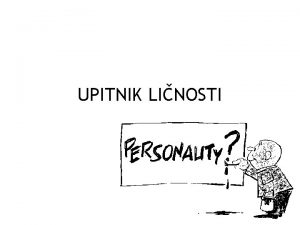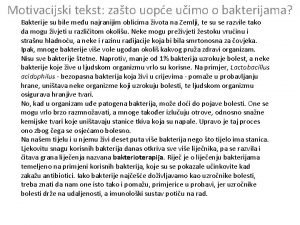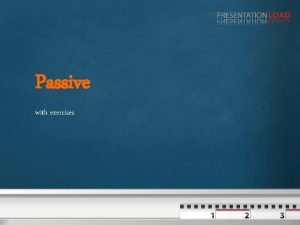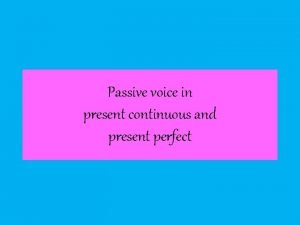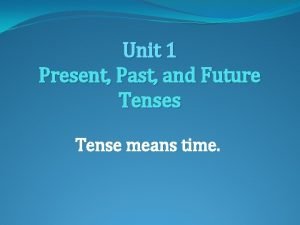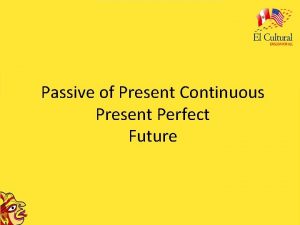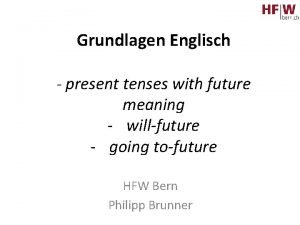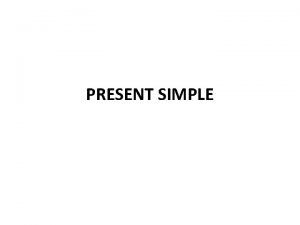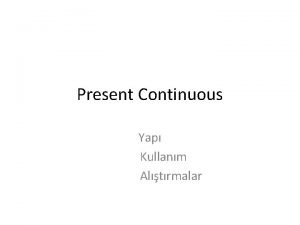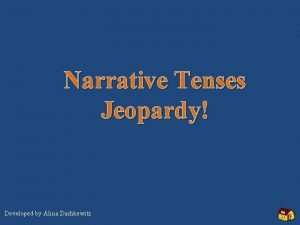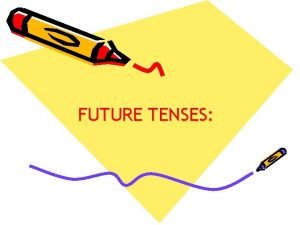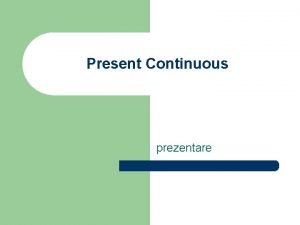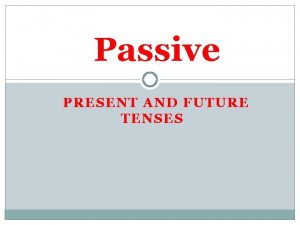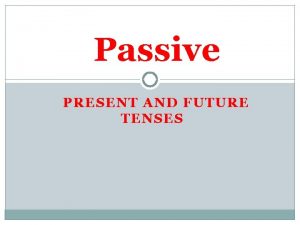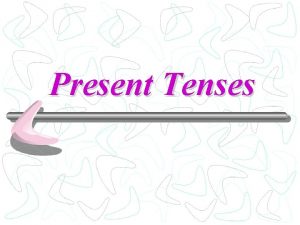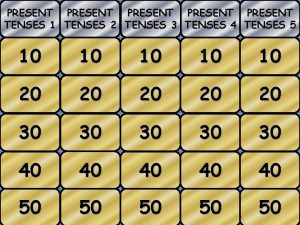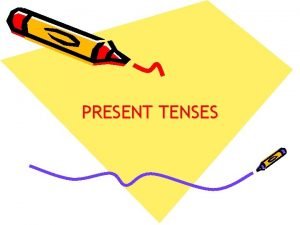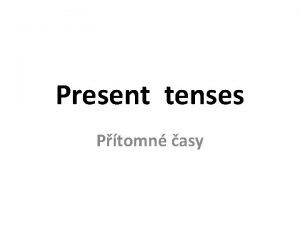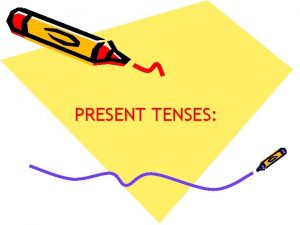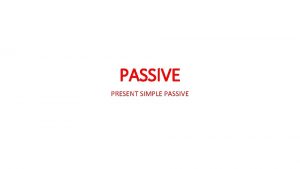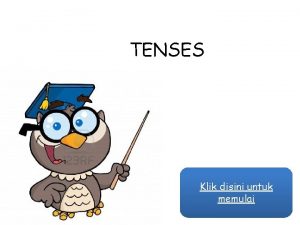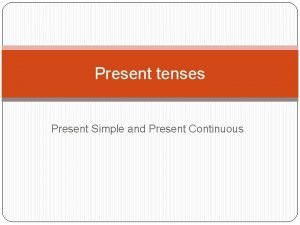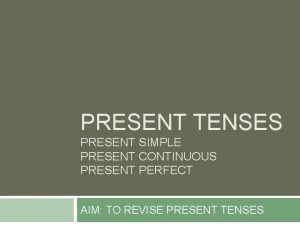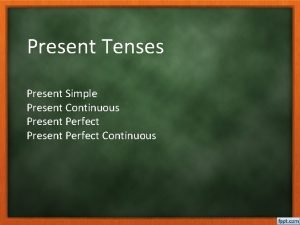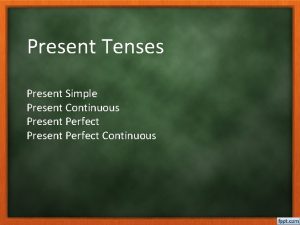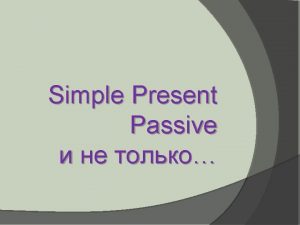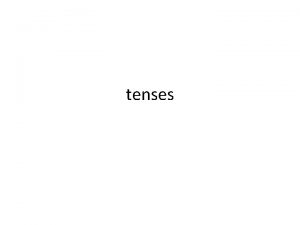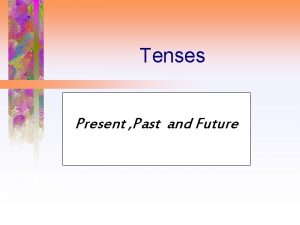Passive PRESENT AND FUTURE TENSES to je uope







![Objekt i pasivne rečenice Samo glagoli koji imaju objekt mogu imati pasivni oblik: [John] Objekt i pasivne rečenice Samo glagoli koji imaju objekt mogu imati pasivni oblik: [John]](https://slidetodoc.com/presentation_image_h2/65d3d34afdcb1794606a54c39608c870/image-8.jpg)
















- Slides: 24

Passive PRESENT AND FUTURE TENSES

Što je uopće pasiv? pasiv nije glagolsko vrijeme (tense), nego način (voice) rečenice koje sadrže objekt (direktni i/ili indirektni) mogu biti u aktivu (active voice) ili u pasivu (passive voice) kod transformacije aktivne u pasivnu rečenicu ne smijemo promijeniti glagolsko vrijeme!

Voice Active Voice indicates that the subject of the verb acts uponthe verb in such sentences. Example: The professor is preparing a presentation. The professor(subject) is doing the preparing (verb). Passive Voice the subject becomes the passive recipient of the action Example: Presentations will be given by students. Presentations (subject) will be givenverb ( ).

Zašto uopće trebamo pasiv? pasivne rečenice su česta pojava u engleskom jeziku koristeći pasivne rečenice pomičemo naglasak s osobe koja vrši radnju (subjekt rečenice) na samu radnju npr. I made some mistakes. → Mistakes were made.

VAŽNO ZA TVORBU ZA PASIVNIH REČENICA nužno je poznavati dijelove rečenice: SUBJEKT: vršitelj radnje npr. The manager wriites reports in his office every day. PREDIKAT: glagol npr. The manager writes reports in his orffice every day. OBJEKT: npr. The manager writtes report s in his office every day. PRILOŽNE OZNAKE: npr. a) The manager writes reports in his office every day. b) The manager writes reports in his office every day. nužno je poznavati i razlikovati glagolska vremena kao i nepravilne glagole

Tvorba pasivnih rečenica objekt aktivne rečenice postaje subjekt pasivne rečenice Subjekt aktivne rečenice se u velikoj većini slučajeva ne mora posebno izricati. Ukoliko ga želimo ili moramo izreći, koristimo by frazu i stavljamo ju na kraj rečenice. [The students]S speak [English]O during the lecture. [English]S is spoken during the lecture [by the students O.

Što učiniti s glagolom? u tvorbi pasiva ne mijenjamo glagolsko vrijeme, nego samo način! pravilo za tvorbu pasiva je: to be + past participle of the main verb - glagol biti (to be) u glagolskom vremenu izvorne aktivne rečenice; npr. ako je aktivna u Present Simple, glagol biti također moramo staviti u to glagolsko vrijeme (am/is/are/was/were) - past particip (past participle) glavnog glagola
![Objekt i pasivne rečenice Samo glagoli koji imaju objekt mogu imati pasivni oblik John Objekt i pasivne rečenice Samo glagoli koji imaju objekt mogu imati pasivni oblik: [John]](https://slidetodoc.com/presentation_image_h2/65d3d34afdcb1794606a54c39608c870/image-8.jpg)
Objekt i pasivne rečenice Samo glagoli koji imaju objekt mogu imati pasivni oblik: [John] S swimms [every day]A. - no O, no passive!

Glagoli s dva objekta Neki glagoli mogu uz sebe imati dva objekta, direktni i indirektni (Od i Oi). Bilo koji od ta dva objekta može biti subjekt pasiva. [He] sends [her]Oi [emails]Od every day. Oi: [She] S is sent emails every day Od: [Emails] S are sent to her ever day. Kada indirektni objekt postaje subjekt pasivne rečenice, mora biti u nominativu: I’ll send her the books. → She will be sent the books.

Pasiv u nekoliko koraka. . . Aktivna rečenica: We keep documents in folders. 1. korak 1. Odrediti subjekt i objekt aktivne rečenice. S O We keep documents in folders. 2. korak Objekt aktivne rečenice postavimo kao subjekt pasivne rečenice. s Documents. . .

We keepdocuments in folders. 3. korak Odredimo glagolsko vrijeme u aktivnoj rečenici: keep Present Simple. Pravilo: glagol to bemoramo staviti u Present Simple , dakle am, isili are(ovisno o licu). Glagol keepje glavni glagol i njega stavljamo u past participle, dakle kept. Documents are kept in folders.

4. korak Ostatak rečenice (priložnu oznaku) smo prepisali, a subjekt glavne rečenice u ovom slučaju nismo uključili. Aktivna rečenica: We keep documents in folders. Pasivna rečenica: Documents are kept in folders.

Future Simple A: They will meet you at the station. P: You will be met at the station. A: You will write the homework. P: The homework will be written.

Future with Going to A: I am going to explain Passive today. P: Passive is going to be explained today. A: Are you going to learn it after the lecture? P: Is it going to be learned after the lecture?

Present. Continuous glagolska vremena tvore pasiv na isti način, iako se continuous oblici za glagol to beinače ne koriste često: to be + V-ed (past participle) A: I am explaining Passive. P: Passive is being explained (by me). A: They are repairingthe bridge. P: The bridge is being repaired. A: Are they producing BMW in Germany? P: Is BMW being produced in Germany?

Pasiv u tablici. . . TENSE/VERB FORM ACTIVE PASSIVE keeps is/are kept Present Continuous is keeping is being kept Future Simple will keep will be kept going to keep going to be kept Present Simple Going to Future

Pasiv u koracima - skraćeno 1. Odrediti S, V, O 2. O (A) → S (P) 3. S (A) → by (P) 4. V (A) → V (P) (pažnja: LICA)

Upotreba pasiva Kada nije potrebno spominjati vršitelja radnje (agent), jer je jasno iz konteksta tko ju vrši: The streets are swept every day. Ako je subjekt aktivne rečenice općenit, npr. people, one: This sort of advertisement is seen everywhere. Kada nas više zanima radnja, nego onaj tko ju vrši: A new public library is being built (by our local council). .

Instrument Ako želimo spomenuti instrument korišten za vršenje radnje koristimo with: Exams are not going to be written with pens.

Negacije u pasivnim rečenicama Usporedite sljedeće rečenice: You won’t do anything. > Nothing will be done. We are not doing enough. > Not enough is being done. > It is not being done enough.

Exercises Our company builds roads/one road every year. Roads arebuilt every year by our company. One road is built every year by our company. Our company is building two roads/a hotel. Our company will build a hotel next year. Our company is going to build a hotel.

EXERCISE 1: Active or Passive? These cars produce / are produced in Japan. 2. German is spoken / speaks in Austria. 3. Somebody cleans / is cleaned the office every day. 4. Somebody will send / will be sent emails. 5. The grass cuts / is cut every day. 6. The exam is writing / is being written by the students. 7. The professor is going to share the ppt online/ is going to be shared online. EXERCISE 2: Change active into passive They grow coffee in Kenya. They publish The Times newspaper in London. They transport oranges from Valencia to Germany. His boss is going to open a new subsidiary. All the students will write the exam. The employee is typing an email. 1. 2. 3. 4. 5. 6.

EXERCISE 3: Complete the table. Object SIMPLE PRESENT PASSIVE The answer PRESENT CONTINUOUS PASSIVE WILL FUTURE GOINT TO FUTURE To be Past participle is given.

Exercise 4: Transform: Active to Passive or vice versa. I confirm the reservation. When is the presentation going to be published by the teacher? Which languages are spoken in Switzerland? We will deliver the goods immediately. English will be learned by students. They execute all orders carefully. Demolition experts are demolishing the old school. Presentation is going to be published online. Who will the homework be written by? Interesting books are written nowadays. Where are the bags put during the exam?
 Uope
Uope Prometni znakovi
Prometni znakovi Uope
Uope Pasivne recenice
Pasivne recenice Simple present continuous passive voice
Simple present continuous passive voice Past tense of breeze
Past tense of breeze Past continuous tense sentences
Past continuous tense sentences Passive voice present perfect simple
Passive voice present perfect simple Present simple passive eat
Present simple passive eat Present future
Present future Affirmative structure
Affirmative structure Present continuous tense alıştırmalar
Present continuous tense alıştırmalar Remember present tense
Remember present tense Future continuous and future perfect exercises pdf
Future continuous and future perfect exercises pdf Esercizi future continuous e future perfect
Esercizi future continuous e future perfect Future and present perfect passive
Future and present perfect passive Passive form of gerunds and infinitives
Passive form of gerunds and infinitives Present simple timetable
Present simple timetable Simple past passive form
Simple past passive form What is passive
What is passive Jeopardy past perfect
Jeopardy past perfect Verb tenses jeopardy
Verb tenses jeopardy There are four future verb tenses in english
There are four future verb tenses in english Schema present continuous
Schema present continuous Present continuous will going to
Present continuous will going to
